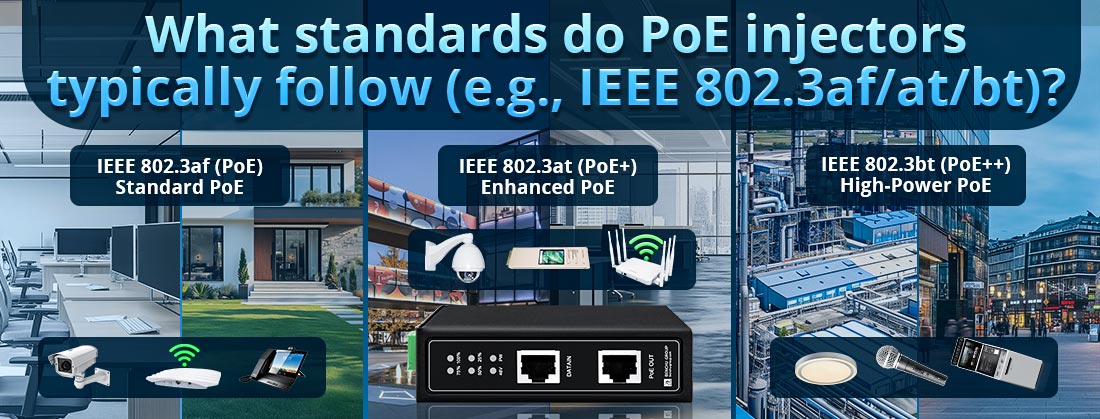
معايير حاقن PoE
توفر حاقنات PoE الطاقة عبر الإيثرنت (PoE) من خلال الجمع بين الطاقة والبيانات في كابل إيثرنت واحد، مما يسمح للأجهزة باستقبال كليهما دون الحاجة إلى أسلاك طاقة منفصلة. تلتزم حاقنات PoE بمعايير محددة لضمان التوافق والسلامة وتوصيل الطاقة بكفاءة. تم وضع المعايير الأكثر شيوعًا التي تتبعها حاقنات PoE من قبل معهد مهندسي الكهرباء والإلكترونيات (IEEE).
فيما يلي وصف تفصيلي للمعايير النموذجية:
1. IEEE 802.3af (PoE) – PoE القياسي
ملخص:
--- تم طرحه في عام 2003، وهو معيار PoE الأصلي.
--- يدعم الأجهزة ذات متطلبات الطاقة المنخفضة.
تحديد:
--- الحد الأقصى لإخراج الطاقة في PSE (معدات مصادر الطاقة): 15.4 وات لكل منفذ.
--- الطاقة المتوفرة في PD (الجهاز الذي يعمل بالطاقة): 12.95 وات (مع حساب فقدان الطاقة عبر كابل Ethernet).
--- الجهد: 44 فولت إلى 57 فولت تيار مستمر.
--- التيار: الحد الأقصى 350 مللي أمبير.
--- أنواع الكابلات المدعومة: Cat5 أو أفضل.
الأجهزة المشتركة المدعومة:
--- هواتف VoIP
--- كاميرات IP الأساسية
--- نقاط وصول لاسلكية بسيطة
--- أجهزة إنترنت الأشياء ذات احتياجات الطاقة المنخفضة (مثل أجهزة الاستشعار).
القيود:
--- غير كافٍ للأجهزة عالية الطاقة مثل كاميرات PTZ أو نقاط وصول Wi-Fi المتقدمة.
2. IEEE 802.3at (PoE+) – PoE المحسن
ملخص:
--- تم طرح هذا المعيار في عام 2009، وتم توسيعه ليشمل 802.3af لدعم الأجهزة ذات الطاقة الأعلى.
تحديد:
--- الحد الأقصى لإخراج الطاقة في PSE: 30 وات لكل منفذ.
--- الطاقة المتوفرة عند PD: 25.5 وات (مع احتساب فقدان الطاقة).
--- الجهد: 50 فولت إلى 57 فولت تيار مستمر.
--- التيار: الحد الأقصى 600 مللي أمبير.
--- أنواع الكابلات المدعومة: Cat5 أو أفضل.
الأجهزة المشتركة المدعومة:
--- كاميرات PTZ
--- نقاط وصول لاسلكية متقدمة (Wi-Fi 5 وبعض موديلات Wi-Fi 6)
--- مفاتيح صغيرة
--- اللافتات والشاشات الرقمية
--- هواتف VoIP المزودة بإمكانيات الفيديو.
المزايا:
--- متوافق مع أجهزة 802.3af.
--- يمكنه تشغيل معظم الأجهزة المستخدمة في الشبكات الصغيرة والمتوسطة الحجم.
3. آي إي إي 802.3 بي تي (بو++ أو 4PPoE) - PoE عالي الطاقة
ملخص:
--- تم طرحه في عام 2018، وهو أحدث معيار للأجهزة ذات متطلبات الطاقة العالية.
--- يدعم توصيل طاقة أعلى بشكل ملحوظ عن طريق استخدام جميع الأزواج الأربعة الملتوية في كابل Ethernet (مقارنة بزوجين في المعايير السابقة).
تحديد:
الحد الأقصى لانتاج الطاقة في PSE:
--- النوع 3: 60 واط لكل منفذ.
--- النوع 4: 100 واط لكل منفذ.
الطاقة المتوفرة في PD:
--- النوع 3: 51 وات (أجهزة النوع 3).
--- النوع 4: 71 وات (أجهزة النوع 4).
--- الجهد: 50 فولت إلى 57 فولت تيار مستمر.
--- التيار: ما يصل إلى 960 مللي أمبير لكل زوج (النوع 3) أو ما يصل إلى 1.5 أمبير لكل زوج (النوع 4).
--- أنواع الكابلات المدعومة: Cat5e أو أفضل للنوع 3؛ Cat6 أو أفضل للنوع 4.
الأجهزة المشتركة المدعومة:
--- كاميرات PTZ مع سخانات/منافيخ للاستخدام الخارجي.
--- نقاط وصول Wi-Fi 6 وWi-Fi 6E المتقدمة.
--- أنظمة الإضاءة LED.
--- أنظمة صوتية متصلة بالشبكة.
--- أجهزة إنترنت الأشياء عالية الطاقة.
--- أكشاك تفاعلية وشاشات عرض رقمية كبيرة.
المزايا:
--- متوافق مع الأجهزة 802.3af و802.3at.
--- يتيح تشغيل أجهزة متعددة أو متعطشة للطاقة باستخدام حاقن PoE واحد.
4. بو السلبي
ملخص:
--- على عكس معايير IEEE، يعتبر Passive PoE تطبيقًا خاصًا لا يتوافق مع معايير 802.3af/at/bt.
--- يوفر الطاقة بجهد ثابت، عادةً 12 فولت، أو 24 فولت، أو 48 فولت، دون التفاوض بشأن الطاقة مع الجهاز الذي يعمل بالطاقة.
تحديد:
--- يختلف الجهد الكهربي وإخراج الطاقة حسب الشركة المصنعة.
--- لا يوجد تفاوض ديناميكي على الطاقة، مما يعني أن الأجهزة يجب أن تتطابق مع الجهد الكهربي المحدد وإخراج الطاقة.
الأجهزة المشتركة المدعومة:
--- أجهزة خاصة من شركات مصنعة معينة (مثل Ubiquiti وMikroTik).
--- أجهزة بسيطة مثل أجهزة الراديو اللاسلكية الصغيرة أو كاميرات IP غير القياسية.
القيود:
--- قد يؤدي عدم وجود توحيد إلى مشاكل التوافق.
--- يجب مطابقة الأجهزة بعناية لتجنب التلف.
مقارنة المعايير
| معيار | الحد الأقصى لانتاج الطاقة (PSE) | الطاقة في PD | الجهد (تيار مستمر) | حاضِر | حالات الاستخدام الشائعة |
| 802.3af | 15.4 واط | 12.95 واط | 44 فولت-57 فولت | 350 مللي أمبير | هواتف VoIP، وكاميرات IP الأساسية، وشبكات WAP |
| 802.3at | 30 واط | 25.5 واط | 50 فولت-57 فولت | 600 مللي أمبير | كاميرات PTZ وشبكات WAP المتقدمة واللافتات |
| 802.3bt | 60 واط (النوع 3) / 100 واط (النوع 4) | 51 واط / 71 واط | 50 فولت-57 فولت | 960 مللي أمبير – 1.5 أمبير | أجهزة عالية الطاقة (Wi-Fi 6 APs، إضاءة LED) |
| بو السلبي | يختلف | يختلف | ثابت (12 فولت، 24 فولت، 48 فولت) | يختلف | الأجهزة الخاصة أو القديمة |
العوامل التي يجب مراعاتها عند اختيار حاقن PoE بناءً على المعايير
توافق الجهاز:
--- تحقق من معيار PoE الخاص بالجهاز الذي يعمل بالطاقة (على سبيل المثال، 802.3af/at/bt) لضمان التوافق.
--- بالنسبة للأجهزة غير القياسية، تحقق من التوافق مع Passive PoE إن أمكن.
متطلبات الطاقة:
--- تحديد القوة الكهربائية التي يحتاجها الجهاز. استخدم حاقنات 802.3bt للأجهزة التي تتطلب طاقة تتجاوز 25.5 وات.
نوع الكابل:
--- تأكد من أن كابلات Ethernet تلبي المواصفات المطلوبة (على سبيل المثال، Cat5e لـ PoE++ Type 3، وCat6 للنوع 4).
التدقيق في المستقبل:
--- اختر حاقنات 802.3bt إذا كنت تخطط لنشر أجهزة عالية الطاقة في المستقبل، حتى لو كانت أجهزتك الحالية تتطلب فقط 802.3af أو 802.3at.
مقياس الشبكة:
--- استخدم المحاقن لعدد فردي أو صغير من الأجهزة. بالنسبة للتركيبات الأكبر حجمًا، فكر في استخدام محولات PoE.
ومن خلال فهم هذه المعايير، يمكنك تحديد أ حاقن بو يتوافق مع متطلبات جهازك وبيئة التثبيت والاحتياجات المستقبلية.